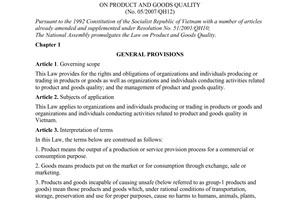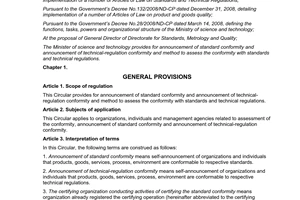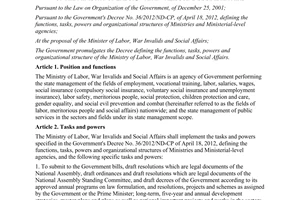Nội dung toàn văn Circular 51/2015/TT-BLĐTBXH national technical regulations safe work engine forklift trucks at least 1000 kg
|
THE MINISTRY OF
LABOR, INVALIDS AND SOCIAL AFFAIRS |
THE SOCIALIST
REPUBLIC OF VIETNAM |
|
Hanoi, December 08, 2015 |
CIRCULAR
NATIONAL TECHNICAL REGULATIONS ON SAFE WORK FOR ENGINE FORKLIFT TRUCKS WITH THE LOAD OF AT LEAST 1,000 KG
Pursuant to the Government's Decree No. 106/2012/NĐ-CP dated December 20, 2012, defining the functions, tasks, powers and organizational structure of the Ministry of Labor, Invalids and Social Affairs;
Pursuant to the Government's Decree No. 127/2007/NĐ-CP dated August 01, 2007 detailing the implementation of a number of articles of the Law on Technical Regulations and Standards;
Pursuant to the Government's Decree No. 132/2008/NĐ-CP dated December 31, 2008, detailing the implementation of a number of articles of the Law on Product and goods Quality;
At requests of the Director of the Bureau of Work Safety, the Minister of Labor, Invalids and Social Affairs hereby issues this Circular promulgating the national technical regulations on safe work for engine forklift trucks with the load of at least 1,000 kg.
Article 1. This Circular is issued together with the national technical regulation on safe work for engine forklift trucks with the load of at least 1,000 kg.
Reference Number: QCVN 25:2015/BLĐTBXH.
Article 2. This Circular enters into force from January 25, 2016.
Article 3. Ministries, ministerial-level agencies, Governmental agencies, People’s Committees of provinces and relevant entities shall be responsible for the implementation of this Circular ./.
|
|
PP. MINISTER |
QCVN 25: 2015/BLĐTBXH
NATIONAL TECHNICAL REGULATIONS ON SAFE WORK FOR ENGINE FORKLIFT TRUCKS WITH THE LOAD OF AT LEAST 1,000 KG
National technical regulation on safe work for Forklift truck use the engine, with load from 1.000kg or more
Preface
QCVN 25: 2015/BLĐTBXH -National technical regulation on safe work for engine forklift trucks with load of at least 1,000kg is compiled by the Bureau of Work Safety, appraised by the Ministry of Science and Technology and issued by the Ministry of Labor, Invalids and Social Affairs under the Circular No.51/2015/TT-BLĐTBXH dated December 08, 2015.
NATIONAL TECHNICA REGULATIONS ON SAFE WORK FOR ENGINE FORKLIFT TRUCKS WITH THE LOAD OF AT LEAST 1,000 KG
1. General provisions
Scope
This Regulation stipulates safety requirements for self-propelled industrial trucks with the load of at least 1,000 kg but not exceeding 10,000 kg and towbars with the force of up to 20,000 N (hereinafter referred to as “forklift truck”).
1.1.2. Forklift trucks operating in hazardous and specialized environment (such as forklift trucks for transport of explosives, chemicals, etc.) shall conform to other respective technical regulations, besides this Regulation.
1.1.3. This regulation shall not apply to:
- Low-lift platform trucks, without cargos (ISO 5053:1987 Powered industrial trucks – Terminology);
- High-lift platform trucks with cargos (ISO 5053:1987 Powered industrial trucks – Terminology);
- Natural gas forklifts;
- Single-axle powered industrial trucks
1.2. Regulated entities
This regulation applies to:
1.2.1. organizations and individuals importing, manufacturing, using and selling forklift trucks.
1.2.2. State regulatory authorities and relevant entities.
1.3. Interpretation
For the purpose of this Regulations, terms herein shall be construed as follows:
1.3.1. Self-propelled industrial trucks
Self-propelled industrial truck refers to any vehicle with an array of wheels (other than those traveling on railways) used for transporting, pulling, pushing, lifting, loading or unloading cargoes of all tonnage, and operated by an operator who may walk along with the truck or ride on the truck.
1.3.2. Operators
Operator refers to a person who has been trained and granted certificates of occupational safety and health and license for operating forklift trucks, and takes all responsibilities for the operation of the forklift truck.
1.3.3. Normal operating position
Normal operating position refers to a position where the operator is able to effectively operate the forklift truck.
1.3.4.Low lift height
Low lift height refers to a lifting height of a forklift truck measured from the floor surface to the bottom of the platform or fork arm. The low lift height shall not exceed 500 mm.
1.3.5. Automatically acting brakes
Automatically acting brake can automatically operate on reserved power of the forklift truck if the forklift truck is out of control.
1.3.6.Rated capacity
Rate capacity is measured by kg decided by the manufacturer within which the forklift truck can work in standard conditions.
1.3.7.Actual capacity
Maximum actual capacity is measured by kg within which the forklift truck can work in normal conditions.
2. Technical provisions
2.1. Specific provisions
2.1.1. Sharp objects within the operator’s working environment and surrounding areas of access and exit roads shall be removed.
2.1.2.Every forklift truck shall be equipped with protective equipment to prevent from being operated by unexpected people.
2.1.3. Components of pedestrian-operated forklift trucks and that of forklift trucks on which operators is riding shall not be exchanged for each other.
2.1.4.Pedestrian-operated forklift trucks and stand-up forklift trucks must be equipped with automatically acting brakes that are as good as manual handbrakes.
2.1.5.Even though a forklift truck may have more than one operator’s seats, at a particular time, the system is activated by only one operation position ( except for emergency shutdown systems).
2.1.6. Speed controller shall be designed to ensure that the pushing of the gear shift level will speed up the forklift truck speed; otherwise, it shall automatically return to zero speed position.
2.1.7. Internal combustion-engine forklift trucks shall be equipped with protective devices to keep the engine from starting up when the gear box is stuck.
2.1.8. Fixed –speed pedestrian-operated forklift trucks shall not reach a speed of exceeding 0.5 km/h and acceleration of exceeding 0.5 m/s2 , and shall only be used for low-lift height.
2.1.9. Variable-speed pedestrian-operated forklift trucks shall not reach a speed of exceeding 6 km/h and the operator’s speed shall be controlled.
2.1.10. The design speed of stand-up forklift truck shall not exceed 16km/h.
2.1.11. In case the transmission is out of work, the automatically acting brake still works as it does in normal conditions .
2.1.12. If the forklift truck is equipped with pedal-operated differential locks, the differential is all locked when the operator takes his/her foot off the pedal.
2.1.13. Ride control systems
2.1.13.1.For stand-up forklift trucks and sit-down forklift trucks, the operator must push the steering wheel in a clockwise motion to move forward.
2.1.13.2. In case the steering system is out of work, the ride control system still maintains its direction until the forklift truck stops.
2.1.13.3.If the ride control system has more than functions, each separate function shall be marked.
2.1.14. Forklift truck cylinders shall be isolated from the electricity system and engine exhaust system by proper measures to ensure the fuel does not permeate into the engine bay, electric components or exhaust system.
2.1.15.Operator safety
2.1.15.1. The operator’s seat and all part of the forklift truck shall be within the reach of the operator when he/she is in his/her normal operating position.
2.1.15.2. Where the cockpit floor is higher than 30 cm, the handle shall be installed and it may be considered as a part of the forklift truck.
2.1.15.3.Where the cockpit floor is higher than 55 cm, a stair shall be installed. The distance between the first step and cockpit floor shall not exceed 55 cm, and so shall the distance between two steps .
2.1.15.4.The cockpit floor of stand-up forklift trucks must be kept from wet or slippery.
2.1.15.5.If the cockpit floor is higher than 1.2 m, protective equipment such as handrails shall be installed.
2.1.16. Protective equipment
2.1.16.1.Sit-down forklift trucks and stand-up forklift trucks with the height of 1,800 mm shall be equipped with overhead and rear visors. The overhead visor is made from rigid-structured materials to protect operators against falling objects.
2.1.16.2. Forklift trucks shall be equipped with audible warning devices.
2.1.17. Operators shall ensure a clear view of path for travel. In case of limited visibility, supporting equipment such as mirrors, cameras, visual and audible warning devices, etc. shall be installed.
2.1.18. Seat belts for stand-up and sit-down operators shall be available.
3. Safety management requirements for forklift truck manufacture, import, trading and use
3.1. Forklift truck technical documents include:
3.1.1. An overall description which specifies:
- Name and address of the manufacturer
- Model number and year of production
- Rated capacity
- Structure drawings and principles of operation, equipment dimensions, main specifications(such as control systems, protective equipment, overload clutches, brake systems)
- Applicable standards
3.1.2. Assembly drawings representing the process of assembly of items and components of a forklift truck such as fork arms, pallets, etc.
3.1.3. Perspective drawings which specify main parameters and dimensions.
3.1.4.Procedures for load testing and inspection, procedures for fault tackling , periodic maintenance and inspection.
3.1.5.Operating manuals
3.2. Safety requirements for forklift trucks made in Vietnam
Every forklift truck made in Vietnam (hereinafter referred to as “domestic forklift truck”) shall::
3.2.1.Have all technical documents specified in item 3.1 of this Regulation enclosed ;
3.2.2. Be declared conformity in accordance with Article 2 of this Regulation, according the certificate of conformity of the certifying agency appointed by the Ministry of Labor, Invalids and Social Affairs.
3.2.2.1. In case of mass production, the certification of conformity shall be carried out in accordance with method 5 - testing typical samples and evaluating the production process; or monitoring the sample testing at the manufacturer or on the market and evaluating the production process ( prescribed the Annex II to the Circular No.28/2012/TT-BKHCN on declaration of conformity and methods of assessment of the conformity with technical regulations and standards dated December 12, 2012 by the Minister of Science and Technology).
3.2.2.2. In case of job production, the certification of conformity shall be carried out in accordance with method 8 - testing or inspecting the entire product (prescribed the Annex II to the Circular No.28/2012/TT-BKHCN on declaration of conformity and methods of assessment of the conformity with technical regulations and standards dated December12, 2012 by the Minister of Science and Technology).
3.2.3. Be registered and declared conformity by their manufacturer after it is certified conformable.
3.2.4. Be certified conformable before being sold on the market.
3.2.5.Undergo the inspection and supervision of quality assurance authorities.
3.3. Safety requirements for imported forklift trucks
3.3.1.Every imported forklift truck shall have all technical documents specified in item 3.1 of this Regulation enclosed;
3.3.2.Imported forklift trucks shall be declared conformity in accordance with Article 2 this Regulation. The declaration of conformity shall be made according to the certificate of conformity by both domestic and overseas certifying agencies recognized or designated by the competent authority.
3.2.2.1. In case of mass import, the certification of conformity shall be carried out in accordance with method 7- testing or inspecting shipments (prescribed the Annex II to the Circular No.28/2012/TT-BKHCN on declaration of conformity and methods of assessment of the conformity with technical regulations and standards dated December12, 2012 by the Minister of Science and Technology).
3.2.2.2. In case of separate importation, the certification of conformity shall be carried out in accordance with method 8: testing or inspecting the entire product (prescribed the Annex II to the Circular No.28/2012/TT-BKHCN on declaration of conformity and methods of assessment of the conformity with technical regulations and standards dated December12, 2012 by the Minister of Science and Technology).
3.3.3. In case of importation of forklift trucks under bilateral or multilateral agreements between competent authorities of the Socialist Republic of Vietnam and exporting countries under which the forklift truck is exempted from quality inspection, such forklift trucks shall be free from quality inspection as it is imported to Vietnam.
3.3.4. Any imported forklift truck failing to satisfy requirements in item 3.1 of this Regulation shall undergo the inspection at checkpoints by inspecting authorities designated or recognized under international agreements to which the Socialist Republic of Vietnam or the competent authority of the Socialist Republic of Vietnam is a signatory.
3.3.5.Imported forklift trucks shall undergo the quality inspection and any violation shall be dealt with in accordance with regulations of laws.
3.3.6. Imported forklift trucks shall be labeled and stamped the conformity mark before being sold on the market.
3.4. Safety requirements for forklift trucks to be sold on the market.
Forklift truck sellers shall :
3.4.1. Comply with national technical regulations on maintenance and trading of forklift trucks and manufacturers' manuals.
3.4.2.Apply quality control measures to maintain quality of forklift trucks.
3.4.3. Have their forklift trucks certified conformable and stamped the conformity mark.
3.4.4.Undergo quality inspection and follow all procedures, regulations and clause on penalties under regulations of laws.
3.5. Requirements for forklift truck maintenance
and repair service providers
Forklift truck maintenance and repair service providers shall:
3.5.1.Be juridical persons and obtain the business registration certificate from the competent authority under the regulation of laws.
3.5.2. Have competent and qualified technicians obtaining the certificate of occupational safety and health under regulations of laws available.
3.5.3.Have sufficient technical facilities and equipment for the maintenance and repair of forklift trucks.
3.5.4. Be liable for fulfillment of their obligations to users as agreed in contracts.
3.5.5.Apply safety measures to maintenance and repair.
3.6.Safety management of forklift truck use
3.6.1. Forklift trucks shall be operated and maintained in accordance with the manufacturer’s operating and maintenance manual.
3.6.2. There shall be an operating manual for each forklift truck.
3.6.3. Every operator and technical manager shall complete required training courses and an initial safety training before taking charge of such positions, and annual safety training courses and shall obtain the certificate of occupational safety & health under regulations of laws. Besides, the operator and technical manager shall thoroughly knowledge of their forklift truck specifications, relevant technical safety standards and regulations and shall be able to cope with incidents, faults and emergencies according to the manufacturer’s manual.
3.6.4. Safety requirements for the use of forklift trucks are as follows:
3.6.4.1. Only forklift trucks in good condition and inspected under regulations of laws are sold on the market. If any defect that may affect the work safety is found during the operation of the forklift truck, the user has the right to request for an early inspection.
3.6.4.2. The logbook for keeping track of regular maintenance or repair shall be available.
3.6.4.3. Forklift trucks shall be operated according to the load and specifications designed by the manufacturer.
3.6.4.4.Safefy measures for people, equipment and works safety within the scope of operation of the forklift truck shall be applied.
3.6.4.5. Every defect shall be promptly remedied.
6. The shift record in which the forklift truck conditions at the beginning and during the shift are recorded must be available and shall be signed by both previous and current shift workers
3.6.4.7.Routine inspections of forklift truck safety and other conditions such as lighting systems, space, etc, shall be carried out prior to the start-up.
3.6.4.8.Measures for preventing non-mission guests from accessing working areas having forklift trucks shall be applied.
3.6.4.9. The forklift truck key shall be kept by the person in charge of safety management of the forklift truck, the spare key shall be transferred to operators in rotation.
3.6.4.10.Preventive measures against explosion or fire shall be applied when transporting explosives or flammable substances.
3.6.4.11. When the shift ends, the empty forklift truck shall be parked at a designated place.
3.6.5.Every employer shall appoint forklift truck operators in writing.
3.6.6.During the operation of forklift trucks, at places where the operator’s visibility is limited, a lookout shall be employed.
3.6.7. Every operator wishing to operate forklift trucks other than those he/she is operating shall complete training courses in new equipment operation. Any operator who does not operate forklift trucks for at least 06 months shall take a test before undertaking their job.
4. Safety inspection of forklift trucks
4.1. Every forklift truck shall undergo an initial inspection and periodic inspections prior to operation, and shall be subject to irregular inspections during the operation in accordance with the inspection procedure issued by the Ministry of Labor, Invalids and Social Affairs.
The safety inspection shall be carried out by a technical safety authority designated by the Bureau of Work safety - Ministry of Labor, Invalids and Social Affairs.
4.2. Inspection frequencies are as follows:
4.2.1.Every forklift truck shall undergo an inspection every three years.
4.2.2. The safety inspection frequency may be increased but reasons for this shall be specified the inspection record.
4.3.Every forklift truck satisfying inspection requirements shall bear an inspection stamp under regulations of the Ministry of Labor, Invalids and Social Affairs.
5. Handling of violations
5.1. The State inspecting authority taking charge of occupational safety shall inspect the implementation of this Regulation and address violations against this Regulation.
5.2. The quality inspection of forklift trucks shall conform to the Law on Goods and Product Quality, and provisions hereof.
6. Responsibilities of relevant organizations and individuals
6.1. Organizations and individuals participating in manufacturing, importing, maintaining, managing and using forklift trucks shall comply with provisions hereof.
6.2.This Regulation is considered as the basis for the inspection and conformity assessment by quality assurance authorities.
7. Implementation organizations
7.1. The Bureau of Work Safety –Ministry of Labor, Invalids and Social Affairs shall provide guidance and conduct the inspection of this Regulation implementation.
7.2. Local regulatory authorities taking charge of occupational safety shall inspect and provide guidance on the implementation of this Regulation.
7.3. This Regulation enters into force after 06 months from the date on which the Circular No.51/2015/TT-BLĐTBXH dated December 08, 2015 is signed.
7.4. Any issue arising in connection with the implementation of this regulation should be promptly reported to the Ministry of Labor, Invalids and Social Affairs./.
------------------------------------------------------------------------------------------------------
This translation is made by LawSoft and
for reference purposes only. Its copyright is owned by LawSoft
and protected under Clause 2, Article 14 of the Law on Intellectual Property.Your comments are always welcomed





